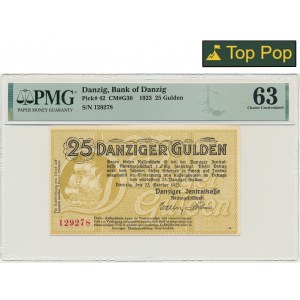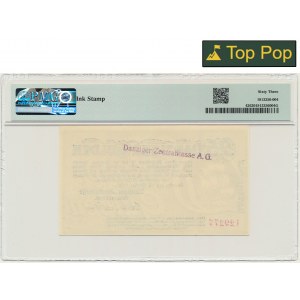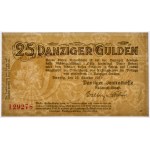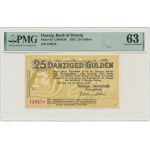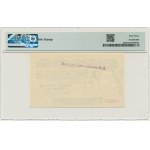The rarest banknote of the Free City of Danzig so far on our auctions!
The highest denomination of the first issue of guilders, dated 22.10.1923.
A spectacular banknote with a distinctive ochre color that makes this banknote visually stand out from all other WMG guilders. The banknote is printed on one side on light cream paper with the watermark "gdansk kogi".
The offered piece is the first representative of this extremely rare banknote to be auctioned through the Onebid platform. In the history of listings on the Polish auction market, one listing from 2003 is known (29th WCN Auction, final price 13,750 PLN). Nevertheless, the piece from the auction 20 years ago was a banknote cancelled on the back with the"Ungültig" stamp.
An analogous piece, also cancelled with the "Ungültig" stamp, was the subject of an offer from a foreign auction house in 2016, which was finally purchased by our company on behalf of a foreign client. The banknote was subjected to PMG grading receiving a PMG 63 EPQ grade.
The piece on offer is the third known banknote with a running number that we have recorded at auctions in Poland and abroad, but the only one that has not been invalidated with the "Ungültig" stamp on the reverse!
Banknote in PMG slab with a PMG grade of 63, which in our opinion does not reflect the actual quality of the banknote on offer. No EPQ due to the"Danziger Zentralkasse A.G." stamp. on the reverse, which is a major inconsistency on PMG's part, as the piece we bought in 2016 and submitted to PMG's evaluation received an EPQ addition, despite the cancellation stamp on the unprinted side. Nonetheless, the banknote that is the subject of the auction bid is still the piece that received the highest numerical bill in the PMG registry, and the only other piece with a PMG 63 bill will not make it to the auction market for another collector generation. It is worth noting that the PMG register shows only two described pieces!
In carefully examining the banknote's state of preservation, we have no qualms at all that this is a banknote in full bank condition. The printing colors and clear embossing leave no illusion that this is a banknote in full printing condition. The corners are naturally sharp and the edges are smooth, with only the tip of the lower left corner showing a slight bend of 1-2 mm. The rest of the banknote area without the slightest remarks. A beautiful, specimen piece.
It is difficult to describe in words how big an event for collectors of banknotes of the Free City of Danzig is today the appearance of the highest denomination of the first issue of guilders. This is the only piece known to us that has not been cancelled, which, combined with the issue's state of preservation, allows us to confidently state that this is the most attractive WMG banknote offered at auction in Poland over the last two decades. An incredible value, an object of every collector's dream, a banknote whose occasion of purchase remains in the memory for years to come, and the excitement of its bidding will manifest itself to everyone gathered in the auction room. A true rarity!
On November 20, 1923, changing the currency from the mark to the guilder set the exchange rate at 1 guilder = 750 billion marks. As the decision to change the currency was made on November 6, 1923, there was not enough time to prepare coins and banknotes. Initially, the Danzig banks established a temporary issuing institution, the Danzig Central Bank, which was to operate until March 31, 1924. It issued one-sided temporary paper money in denominations: 1, 2, 5, 10, 25 and 50 fenges and 1, 2, 5, 10, 25, 50 and 100 guilders. The money was a means of payment until April 30, 1924. After that date, they were exchanged for Bank of Danzig (Bank von Danzig) money for six months. The first guilder bills of the new Danzig issuing institution appeared in circulation in mid-March 1924. They all have the same style. Their design included the great coat of arms of the city, elements of city architecture and sculptural detail. All guilder banknotes were printed at the British securities printer Bradbury, Wilkinson & Co. Ltd, New Malden, Surrey.
